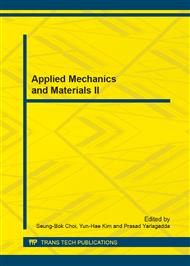p.1192
p.1196
p.1205
p.1210
p.1214
p.1225
p.1229
p.1234
p.1238
Mechanism of Micro-Void Initiation in Composite Materials during VaRTM Process According to the Pressure and Thickness of the Impurity
Abstract:
The purpose of this study is the evaluation about the Micro-void generated by the impurity. The glass fiber reinforced composite made through the vacuum bag molding method was used with the impurity. The basalt fiber known as environment-friendly fiber was used as the fiber of the Micro-void specimen and the epoxy resin was used as the base material. The VaRTM process was performed for the making specimens. The change was given to the thickness of the impurity and pressure in order to see about production of the void. Consequently, as the thickness of the foreign material became thick and the pressure was enhanced, the size of the void grew and the production frequency of the void was enhanced.
Info:
Periodical:
Pages:
1214-1221
Citation:
Online since:
December 2013
Keywords:
Price:
Сopyright:
© 2014 Trans Tech Publications Ltd. All Rights Reserved
Share:
Citation:


